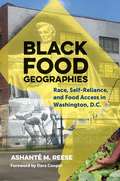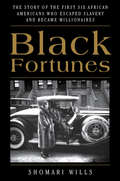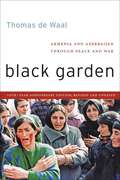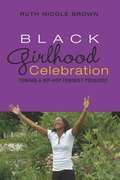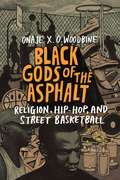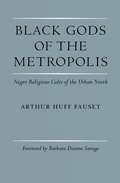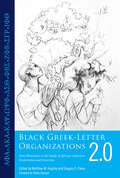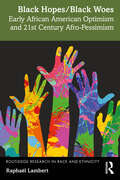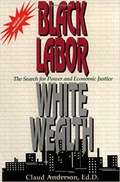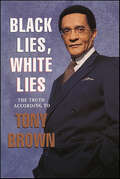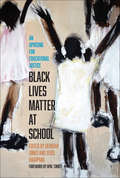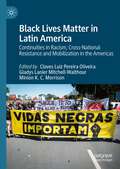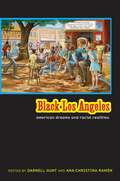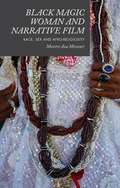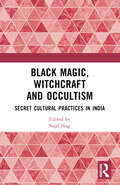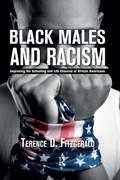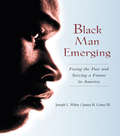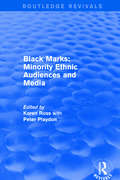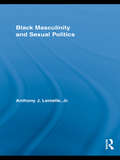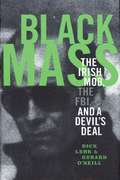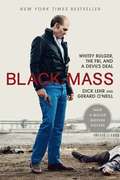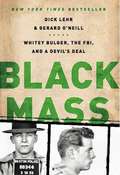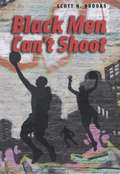- Table View
- List View
Black Food Geographies: Race, Self-Reliance, and Food Access in Washington, D.C.
by Ashanté M. ReeseIn this book, Ashante M. Reese makes clear the structural forces that determine food access in urban areas, highlighting Black residents' navigation of and resistance to unequal food distribution systems. Linking these local food issues to the national problem of systemic racism, Reese examines the history of the majority-Black Deanwood neighborhood of Washington, D.C. Based on extensive ethnographic fieldwork, Reese not only documents racism and residential segregation in the nation's capital but also tracks the ways transnational food corporations have shaped food availability. By connecting community members' stories to the larger issues of racism and gentrification, Reese shows there are hundreds of Deanwoods across the country. Reese's geographies of self-reliance offer an alternative to models that depict Black residents as lacking agency, demonstrating how an ethnographically grounded study can locate and amplify nuances in how Black life unfolds within the context of unequal food access.
Black Food Geographies: Race, Self-reliance, And Food Access In The Nation's Capital
by Ashanté ReeseIn this book, Ashante M. Reese makes clear the structural forces that determine food access in urban areas, highlighting Black residents' navigation of and resistance to unequal food distribution systems. Linking these local food issues to the national problem of systemic racism, Reese examines the history of the majority-Black Deanwood neighborhood of Washington, D.C. Based on extensive ethnographic fieldwork, Reese not only documents racism and residential segregation in the nation's capital but also tracks the ways transnational food corporations have shaped food availability. By connecting community members' stories to the larger issues of racism and gentrification, Reese shows there are hundreds of Deanwoods across the country. Reese's geographies of self-reliance offer an alternative to models that depict Black residents as lacking agency, demonstrating how an ethnographically grounded study can locate and amplify nuances in how Black life unfolds within the context of unequal food access.
Black Fortunes: The Story of the First Six African Americans Who Escaped Slavery and Became Millionaires
by Shomari Wills<p>The astonishing untold history of America’s first black millionaires—former slaves who endured incredible challenges to amass and maintain their wealth for a century, from the Jacksonian period to the Roaring Twenties—self-made entrepreneurs whose unknown success mirrored that of American business heroes such as Henry Ford, John D. Rockefeller, and Thomas Edison. <p>While Oprah Winfrey, Jay-Z, Beyoncé, Michael Jordan, and Will Smith are among the estimated 35,000 black millionaires in the nation today, these famous celebrities were not the first blacks to reach the storied one percent. Between the years of 1830 and 1927, as the last generation of blacks born into slavery was reaching maturity, a small group of smart, tenacious, and daring men and women broke new ground to attain the highest levels of financial success. <p>Black Fortunes is an intriguing look at these remarkable individuals, including Napoleon Bonaparte Drew—author Shomari Wills’ great-great-great-grandfather—the first black man in Powhatan County (contemporary Richmond) to own property in post-Civil War Virginia. His achievements were matched by five other unknown black entrepreneurs including: <p> <li>Mary Ellen Pleasant, who used her Gold Rush wealth to further the cause of abolitionist John Brown; <li>Robert Reed Church, who became the largest landowner in Tennessee; <li>Hannah Elias, the mistress of a New York City millionaire, who used the land her lover gave her to build an empire in Harlem; <li>Orphan and self-taught chemist Annie Turnbo-Malone, who developed the first national brand of hair care products; <li>Madam C. J Walker, Turnbo-Malone’s employee who would earn the nickname America’s "first female black millionaire;" <li>Mississippi school teacher O. W. Gurley, who developed a piece of Tulsa, Oklahoma, into a "town" for wealthy black professionals and craftsmen" that would become known as "the Black Wall Street."</li> <p> <p>A fresh, little-known chapter in the nation’s story—A blend of Hidden Figures, Titan, and The Tycoons—Black Fortunes illuminates the birth of the black business titan and the emergence of the black marketplace in America as never before.</p>
Black Garden: Armenia and Azerbaijan through Peace and War
by Thomas de Waal“Brilliant.”—Time “Admirable, rigorous. De Waal [is] a wise and patient reporter.”—The New York Review of Books “Never have all the twists and turns, sad carnage, and bullheadedness on all side been better described—or indeed, better explained…Offers a deeper and more compelling account of the conflict than anyone before.”—Foreign Affairs Since its publication in 2003, the first edition of Black Garden has become the definitive study of how Armenia and Azerbaijan, two southern Soviet republics, were pulled into a conflict that helped bring them to independence, spell the end the Soviet Union, and plunge a region of great strategic importance into a decade of turmoil. This important volume is both a careful reconstruction of the history of the Nagorny Karabakhconflict since 1988 and on-the-spot reporting of the convoluted aftermath. Part contemporary history, part travel book, part political analysis, the book is based on six months traveling through the south Caucasus, more than 120 original interviews in the region, Moscow, and Washington, and unique historical primary sources, such as Politburo archives. The historical chapters trace how the conflict lay unresolved in the Soviet era; how Armenian and Azerbaijani societies unfroze it; how the Politiburo failed to cope with the crisis; how the war was fought and ended; how the international community failed to sort out the conflict. What emerges is a complex and subtle portrait of a beautiful and fascinating region, blighted by historical prejudice andconflict.The revised and updated 10th-year anniversary edition includes a new forward, a new chapter covering developments up to-2011, such as the election of new presidents in both countries, Azerbaijan’s oil boom and the new arms race in the region, and a new conclusion, analysing the reasons for the intractability of the conflict and whether there are any prospects for its resolution. Telling the story of the first conflict to shake Mikhail Gorbachev's Soviet Union, Black Garden remains a central account of the reality of the post-Soviet world.
Black Girlhood Celebration: Toward A Hip-Hop Feminist Pedagogy
by Ruth Nicole BrownThe celebration of Black girlhood is essential their principles and practices were the centred program. It examines how performances of everyday Black girlhood are mediated by popular culture, personal truths, and lived experiences, and how the discussion and critique of these factors can be a great asset in the celebration of Black girls.
Black Gods of the Asphalt: Religion, Hip-Hop, and Street Basketball
by Onaje X. WoodbineJ-Rod moves like a small tank on the court, his face mean, staring down his opponents. "I play just like my father," he says. "Before my father died, he was a problem on the court. I'm a problem." Playing basketball for him fuses past and present, conjuring his father's memory into a force that opponents can feel in each bone-snapping drive to the basket. On the street, every ballplayer has a story. Onaje X. O. Woodbine, a former streetball player who became an all-star Ivy Leaguer, brings the sights and sounds, hopes and dreams of street basketball to life. He shows that big games have a trickster figure and a master of black talk whose commentary interprets the game for audiences. The beats of hip-hop and reggae make up the soundtrack, and the ballplayers are half-men, half-heroes, defying the ghetto's limitations with their flights to the basket.Basketball is popular among young black American men but not because, as many claim, they are "pushed by poverty" or "pulled" by white institutions to play it. Black men choose to participate in basketball because of the transcendent experience of the game. Through interviews with and observations of urban basketball players, Onaje X. O. Woodbine composes a rare portrait of a passionate, committed, and resilient group of athletes who use the court to mine what urban life cannot corrupt. If people turn to religion to reimagine their place in the world, then black streetball players are indeed the hierophants of the asphalt.
Black Gods of the Metropolis
by Arthur Huff Fauset John Szwed Barbara Dianne SavageStemming from his anthropological field work among black religious groups in Philadelphia in the early 1940s, Arthur Huff Fauset believed it was possible to determine the likely direction that mainstream black religious leadership would take in the future, a direction that later indeed manifested itself in the civil rights movement. The American black church, according to Fauset and other contemporary researchers, provided the one place where blacks could experiment without hindrance in activities such as business, politics, social reform, and social expression. With detailed primary accounts of these early spiritual movements and their beliefs and practices, Black Gods of the Metropolis reveals the fascinating origins of such significant modern African American religious groups as the Nation of Islam as well as the role of lesser known and even forgotten churches in the history of the black community.In her new foreword, historian Barbara Dianne Savage discusses the relationship between black intellectuals and black religion, in particular the relationship between black social scientists and black religious practices during Fauset's time. She then explores the complexities of that relationship and its impact on the intellectual and political history of African American religion in general.
Black Greek-Letter Organizations 2.0: New Directions in the Study of African American Fraternities and Sororities
by Gregory S. Parks Matthew W. HugheyAt the turn of the twentieth century, black fraternities and sororities, also known as Black Greek-Letter Organizations (BGLOs), were an integral part of what W.E.B. Du Bois called the “talented tenth.” This was the top ten percent of the black community that would serve as a cadre of educated, upper-class, motivated individuals who acquired the professional credentials, skills, and capital to assist the race to attain socioeconomic parity. Today, however, BGLOs struggle to find their place and direction in a world drastically different from the one that witnessed their genesis. In recent years, there has been a growing body of scholarship on BGLOs. This collection of essays seeks to push those who think about BGLOs to engage in more critically and empirically based analysis. This book also seeks to move BGLO members and those who work with them beyond conclusions based on hunches, conventional wisdom, intuition, and personal experience. In addition to a rich range of scholars, this volume includes a kind of call and response feature between scholars and prominent members of the BGLO community.
Black Hopes/Black Woes: Early African American Optimism and 21st Century Afro-Pessimism (Routledge Research in Race and Ethnicity)
by Raphaël LambertBlack Hopes/Black Woes begins by delving into the contrasting mindsets of postbellum African Americans and their twenty-first-century counterparts, aiming to elucidate the shift from early Black optimism to present-day Black pessimism. It then focuses on the rationale behind Afro-pessimism, a contemporary school of thought with an inconspicuous yet potent influence on mainstream culture.The first part of the book focuses on Frederick Douglass’s and WEB Du Bois’s interpretations of slave songs, establishing a link between the Negro, freedom, and democracy. This optimistic view is juxtaposed with Saidiya Hartman’s, who, with 100 years’ hindsight, condemns Du Bois’s reformist spirit and efforts to tackle Black poverty as supercilious and damaging. The book then scrutinizes Afro-pessimism through the work of Frank B. Wilderson III, who posits that the stability of civil society hinges on anti-Black violence. Accordingly, he argues that any analogy between Black and non-Black experiences is flawed and that Marxism, which privileges labor over racial issues, is inadequate to grasp Blackness. Additionally, the book explores the essentialist discourse of Afro-pessimism through David Marriott’s analysis of Frantz Fanon, which theorizes the non-beingness of Blackness despite Fanon’s focus on being colonized rather than Black. Finally, the book demonstrates how Afro-pessimism overlaps with postcolonialism and conflicts with Fanon’s universalism, his rejection of identity politics, and his advocacy for transracial and transnational dialogue.While the radical nature of Afro-pessimism may seem to manifest an unresolved national trauma, Black Hopes/Black Woes situates this ideology in the larger contemporary philosophical and critical discourse, shedding light on its propensity to foster a culture of resentment and cynicism. Once confined to a niche academic audience, Afro-pessimism has percolated the mainstream, stoking the fire of racial antagonism.
Black Labor, White Wealth: The Search for Power and Economic Justice
by Claud AndersonDr. Anderson's first book is a classic. It tracks slavery and Jim Crow public policies that used black labor to construct a superpower nation. It details how black people were socially engineered into the lowest level of a real life Monopoly game, which they are neither playing or winning. Black Labor is a comprehensive analysis of the issues of race. Dr. Anderson uses the analysis in this book to offer solutions to America's race problem.
Black Lies, White Lies: The Truth According to Tony Brown
by Tony BrownPBS television commentator and syndicated radio talk-show host Tony Brown has been called an "out-of-the-box thinker" and, less delicately, and "equal opportunity ass kicker." Those who attempt to pigeonhole him do so at their own peril. This journalist, media commentator, self-help advocate, entrepreneur, public speaker, film director, and author is a hard man to pin a label on -- and an even more difficult man to fool.In Black Lies, White Lies, Tony Brown does what few high-profile African Americans have done before: He dares to challenge the lies of both Black and White leaders, and he dares to tell the truth. He attacks White racism and Black self-victimization with equal vehemence. He condemns integration as a disastrous policy, not for just Blacks but for the entire country. And he confronts the Black Talented Tenth, White liberals, conservatives, Democrats, Republicans, demagogues, and racists on all sides for their self-serving lies, their failures, and their lack of vision.But Tony Brown does not simply slash and burn. He also offers farsighted, workable solutions to America's problems. He provides a blueprint for American renewal bases on his belief that although we may not have come to this country on the same ship, we are all now in the same boat.
Black Lives Matter at School: An Uprising for Educational Justice
by Denisha Jones, Jesse HagopianThis inspiring collection of accounts from educators and students is “an essential resource for all those seeking to build an antiracist school system” (Ibram X. Kendi).Since 2016, the Black Lives Matter at School movement has carved a new path for racial justice in education. A growing coalition of educators, students, parents and others have established an annual week of action during the first week of February. This anthology shares vital lessons that have been learned through this important work.In this volume, Bettina Love makes a powerful case for abolitionist teaching, Brian Jones looks at the historical context of the ongoing struggle for racial justice in education, and prominent teacher union leaders discuss the importance of anti-racism in their unions. Black Lives Matter at School includes essays, interviews, poems, resolutions, and more from participants across the country who have been building the movement on the ground.
Black Lives Matter in Latin America: Continuities in Racism, Cross-National Resistance and Mobilization in the Americas
by Minion K. C. Morrison Cloves Luiz Pereira Oliveira Gladys Lanier Mitchell-WalthourThis volume considers how Black activism in Latin America has taken place in varying arenas such as in the academy, digital platforms, and traditional forms of activism. Contributors also examine the impact of activism on policy advocacy and legislation, as well as groups who the Black Lives Matter movement focus on such as women and immigrants. The first part of the book focuses on making Black Lives Matter in academic studies, governmental data, and politics. The next section focuses on the impact of Black activism on policy and legislation in Brazil, Colombia, and Peru. Black activists have been fighting for Black lives throughout Latin America and their struggles have not been in vain, although less policy change has occurred in Peru. The last section finds that social media has allowed for more independent forms of Black activism in Brazil and Cuba.
Black Los Angeles: American Dreams and Racial Realities
by Ana-Christina Ramon Darnell HuntAn in-depth analysis of the historical and contemporary contours of Black life in Los Angeles.Black Los Angeles is the culmination of a groundbreaking research project from the Ralph J. Bunche Center for African American Studies at UCLA that presents an in-depth analysis of the historical and contemporary contours of Black life in Los Angeles. Based on innovative research, the original essays collected here are multi-disciplinary in approach and comprehensive in scope, connecting the dots between the city&’s racial past, present, and future. Through historical and contemporary anecdotes, oral histories, maps, photographs, illustrations, and demographic data, we see that Black L.A. is and has always been a space of profound contradictions. Just as Los Angeles has come to symbolize the complexities of the early 21st century city, so too has Black Los Angeles come to embody the complex realities of race in so-called &“colorblind&” times.Contributors: Melina Abdullah, Alex Alonso, Dionne Bennett, Joshua Bloom, Edna Bonacich, Scot Brown, Reginald Chapple, Lola Smallwood Cuevas, Andrew Deener, Regina Freer, Jooyoung Lee, Mignon R. Moore, Lanita Morris, Neva Pemberton, Steven C. Pitts, Carrie Petrucci, Gwendelyn Rivera, Paul Robinson, M. Belinda Tucker, Paul Von Blum, Mary Weaver, Sonya Winton, and Nancy Wang Yuen.
Black Magic Woman and Narrative Film: Race, Sex and Afro-Religiosity
by Montré Aza MissouriBlack Magic Woman and Narrative Film examines the transformation of the stereotypical 'tragic mulatto' from tragic to empowered, as represented in independent and mainstream cinema. The author suggests that this transformation is through the character's journey towards African-based religions.
Black Magic, Witchcraft and Occultism: Secret Cultural Practices in India
by Sajal NagBlack magic, occult practices and witchcraft still evoke huge curiosity, interest and amazement in the minds of people. Although witchcraft in Europe has been a widely studied phenomenon, black magic and occult are not yet a popular theme of academic research, even though India is known as a land of magic, tantra and occult. The Indian State of Assam was historically feared as the land of Kamrup-Kamakhya, black magic, witchcraft and occultic practices. It was where different Tantric cults as well as other occult practices thrived. The Khasi Hills are known for the practice of snake vampire worship. The village of Mayong is the village, where magic and occult is still practiced as a living tradition. This book is one of the rarest collections where such practices are researched, recorded and academically analyzed. It is one of those collections where studies of all three practices of Black Magic, Witchcraft and Occult are comibned into one single book.
Black Males and Racism: Improving the Schooling and Life Chances of African Americans
by Terence D. FitzgeraldBehind the twenty-first-century curtain of "colorblind" public sentiment lies an often-ignored reality shared by many African American males—racism continues to thrive and often drastically affects their lives. Fitzgerald draws on his extensive interviews of black males to reveal the experiences of racism that continue in public schools and in American higher education.Using empirical data and the methods of sociological research, Fitzgerald analyzes how the persistent effects of white supremacy in education have threatened the psychological and economic welfare of black males. The effects often last well into adulthood. Unraveling the subtle and overt mechanisms of institutional social control leads Fitzgerald to proposals to reduce structural racism and improve the lives of African American youth.
Black Man Emerging: Facing the Past and Seizing a Future in America
by Joseph L. White James H. Cones IIIFirst published in 2000. Routledge is an imprint of Taylor & Francis, an informa company.
Black Marks: Minority Ethnic Audiences and Media
by Karen Ross Peter PlaydonThis title was first published in 2001. This text brings together a collection of empirical studies focusing on the relationships which minority ethnic audiences have with and to media texts, both mainstream and minority. The media which comprise the focus for the essays include television, film, advertising, magazines and the press. The field of media studies has moved beyond the model of media consumer as passive recipient towards individuals and groups who are altogether more engaged, responsive and critical. But studies of the interactive media consumer often fail to consider the specific characteristics of "race" and ethnicity which come into play for minority ethnic audiences, and this book aims to add to the limited knowledge of the ways in which ethnic markers intervene in textual understanding and contestation.
Black Masculinity and Sexual Politics: Black Masculinity And The Politics Of Passing (Routledge Research in Race and Ethnicity)
by Anthony J. Lemelle, Jr.African American males occupy a historically unique social position, whether in school life, on the job, or within the context of dating, marriage and family. Often, their normal role expectations require that they perform feminized and hypermasculine roles simultaneously. This book focuses on how African American males experience masculinity politics, and how U.S. sexism and racial ranking influences relationships between black and white males, as well as relationships with black and white women. By considering the African American male experience as a form of sexism, Lemelle proposes that the only way for the social order to successfully accommodate African American males is to fundamentally eliminate all sexism, particularly as it relates to the organization of families.
Black Mass
by Dick Lehr Gerard O'NeillTwo boys - John Connolly and James "Whitley" Bulger - grew up together on the streets of South Boston. Decades later, in the mid-1970s, they would meet again. By then, Connolly was a major figure in the FBI's Boston office and Whitley had become godfather of the Irish mob. Connolly had an idea, a scheme that might bring Bulger into the FBI fold and John Connolly into the Bureau's big leagues. But Bulger had other plans. "Black Mass" is the story of what happened beween them - a dark deal to trade secrets and take down Boston's Italian Mafia in exchange for "immunity" - that spiralled out of control, leading to murders, drug dealing and racketeering indictments. Ultimately, in what would become the biggest internal scandal in the history of the FBI, Bulger would find himself at the top of the FBI's Ten Most Wanted List. Told in gripping narrative style by the "Boston Globe" reporters who covered the case from the beginning, "Black Mass" is a riveting epic crime story that is also a book about Irish America, about the pull of place, and about the ties that bind.
Black Mass
by Dick Lehr Gerard O'NeillJohn Connolly and James "Whitey" Bulger grew up together on the tough streets of South Boston. Decades later in the mid-1970s, they met again. By then, Connolly was a major figure in the FBI's Boston office and Whitey had become godfather of the Irish Mob. Connolly had an idea, a scheme that might bring Bugler into the FBI fold and John Connolly into the Bureau's big leagues. But Bulger had other plans. Soon to be a major motion picture starring Johnny Depp as Whitey Bulger, Black Mass is the chilling true story of what happened between them--a dark deal that spiraled out of control, leading to drug dealing, racketeering, and murder.
Black Mass
by Dick Lehr Gerard O'NeillJohn Connolly and James "Whitey" Bulger grew up together on the tough streets of South Boston. Decades later in the mid-1970s, they met again. By then, Connolly was a major figure in the FBI's Boston office and Whitey had become godfather of the Irish Mob. Connolly had an idea, a scheme that might bring Bugler into the FBI fold and John Connolly into the Bureau's big leagues. But Bulger had other plans. Soon to be a major motion picture starring Johnny Depp as Whitey Bulger, Black Mass is the chilling true story of what happened between them--a dark deal that spiraled out of control, leading to drug dealing, racketeering, and murder.
Black Mass: Whitey Bulger, the FBI, and a Devil's Deal
by Dick Lehr Gerard O'NeillJohn Connolly and James "Whitey" Bulger grew up together on the tough streets of South Boston. Decades later in the mid-1970s, they met again. By then, Connolly was a major figure in the FBI's Boston office and Whitey had become godfather of the Irish Mob. Connolly had an idea, a scheme that might bring Bugler into the FBI fold and John Connolly into the Bureau's big leagues. But Bulger had other plans. Soon to be a major motion picture starring Johnny Depp as Whitey Bulger, Black Mass is the chilling true story of what happened between them--a dark deal that spiraled out of control, leading to drug dealing, racketeering, and murder.
Black Men Can't Shoot
by Scott N. BrooksThe myth of the natural black athlete is widespread, though it's usually only talked about when a sports commentator or celebrity embarrasses himself by bringing it up in public. Those gaffes are swiftly decried as racist, but apart from their link to the long history of ugly racial stereotypes about black people--especially men--they are also harmful because they obscure very real, hard-fought accomplishments. As Black Men Can't Shoot demonstrates, such successes on the basketball court don't just happen because of natural gifts--instead, they grow out of the long, tough, and unpredictable process of becoming a known player. Scott N. Brooks spent four years coaching summer league basketball in Philadelphia. And what he saw, heard, and felt working with the young black men on his team tells us much about how some kids are able to make the extraordinary journey from the ghetto to the NCAA. To show how good players make the transition to greatness, Brooks tells the story of two young men, Jermaine and Ray, following them through their high school years and chronicling their breakthroughs and frustrations on the court as well as their troubles at home. We witness them negotiating the pitfalls of forging a career and a path out of poverty, we see their triumphs and setbacks, and we hear from the network of people--their families, the neighborhood elders, and Coach Brooks himself--invested in their fates. Black Men Can't Shoot has all the hallmarks of a classic sports book, with a climactic championship game and a suspenseful ending as we wait to find out if Jermaine and Ray will be recruited. Brooks's moving coming-of-age story counters the belief that basketball only exploits kids and lures them into following empty dreams--and shows us that by playing ball, some of these young black men have already begun their education even before they get to college.

